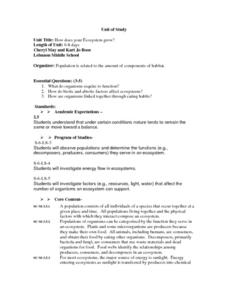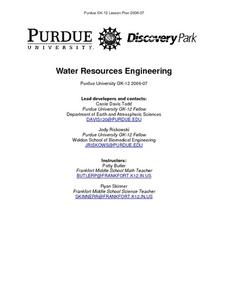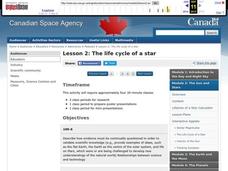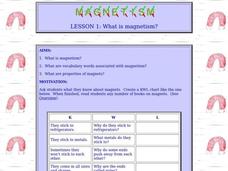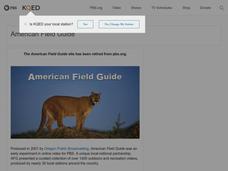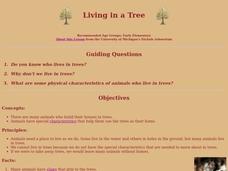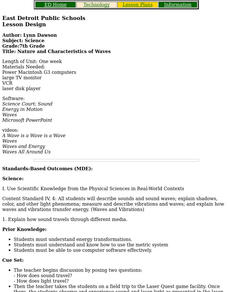Curated OER
Make a Comet Model and Eat It!
Students construct a comet model based on procedure provided. In this space science instructional activity, students compare the physical properties of comets to the models they made. They record their observations and share them with...
Curated OER
How Does Your Ecosystem Grow?
Students consider that under certain conditions in nature tend to remain the same or move toward a balance. They observe populations and determine the functions (e.g., de-composers, producers, consumers) they serve in an ecosystem. They...
Curated OER
Basics of Archaeology
Students identify what and how to complete an Archaeological excavation is conducted. They identify the transition from one layer to the next more easily if the colors of the layers are different. When creating a dig, the teacher...
Curated OER
Adhesives: Measuring Stickiness
Students test the stickiness of natural substances. In this adhesion as a property of matter lesson, students build a tool to test the adhesion of natural "glues" such as honey, peanut butter, flour and water paste, and jelly. Students...
Curated OER
Time-delay Electromechanical Relays
In this physics worksheet, students solve and write short answers to 19 questions on time-delay relays. They explain how the mechanism works and calculate the amount of delay in seconds.
Curated OER
Design a Reef!
Students explore coral reef ecosystems. In this ecosystems science instructional activity, students research coral reef ecosystems to determine the major functions the participating organisms must perform. Students construct...
Curated OER
Water Resources Engineering
Students illustrate the chemical differences between surface and tap-water. They investigate the common chemical and physical parameters relevant for water quality and gain hands on experience with water quality testing.
They enhance...
Curated OER
Hawaii's Freshwater Ecosystems
Learners examine brackish water. In this Science lesson plan, students observe organisms found in brackish water. Learners record their observations of the various organisms.
Curated OER
The Life Cycle of a Star
Young scholars investigate the life cycle of a star and make conclusions based on evidence, research, and observation. In this lesson on space and scientific investigation, students describe the relationships between science and...
Curated OER
Global Warming
First graders discover the effects of global warming on polar bears. In this life science lesson, 1st graders model the polar bear's habitat and observe what happens as they raise the temperature. They record their observation in the...
Curated OER
Paleoclimates and Pollen
Students analyze soil for types of pollen to determine the probably climate conditions. In this earth science lesson, students make conclusions on what a climate is like based on soils samples. Students use a model soil...
Curated OER
What is Magnetism?
Students investigate magnetism. In this physics lesson, students create a KWL chart about magnetism and research various suggested websites to find out more about magnetism. Students log on to the "BrainPOP" website and view a short...
Curated OER
Sound Waves
Students explore sound. In this "sound" science lesson, students define sound and explain how sound travels. Students experiment with paper cups and string to conclude how sound travels. Students research a chosen aspect of sound with a...
Curated OER
Let it Roll!
Students explore how various ramps affect the rate of speed of a rolling object. In this physics lesson, students work in groups to build a ramp out of various materials. Students test and record the rate of speed of a rolling object by...
Curated OER
Magnetic Field Activities
Students explore the idea of magnetic field through investigations of magnetic fields as produced by various common magnetic materials and direct currents. They study the vector nature of fields, the ubiquity of field sources in the...
Curated OER
Flowers and Plants
Students are assigned to bring five flowers. They explore flowers to distinguish different physical features of flowers. They compare and contrast different flowers to determine what features they have in common. Students develop an...
Curated OER
Living in a Tree
Students explore animals that live in trees. In this nature and biology lesson, students go outdoors and make observations about animals and their unique body parts that help them to live in trees. Students create drawings as they...
Curated OER
Light
Students explore light. In this light wave physics lesson, students construct periscopes, kaleidoscopes, color wheels, and pinhole cameras. Students observe and record characteristics of light demonstrated through the use of...
Curated OER
Introduction to the Periodic Table of Elements
Students explain how the elements are arranged in the periodic table. In this chemistry lesson, students determine the subatomic particles for certain elements. They research the physical and chemical properties of an element they chose.
Curated OER
Energy Activities
Students conduct a variety of experiments related to solar energy, heating, cooling, gravity, physical insulation and wind. They consider how the experiments relate to energy and the consumption of energy and then participate in a class...
Curated OER
Energy: The Universal Currency
Science stars examine the concept of energy by thinking about everyday situations. The lesson plan is incohesive. It lists goals for the student, but doesn't address all of them in the content. The best use of this resource would simply...
Curated OER
What was Newton's Idea of Science?
Students form logical foundations for analysis of observations. They improve analytic reading abilities through practice. Students investigate the foundations of scientific thought processes and how to apply them.
Curated OER
Nature and Characteristics of Waves
Seventh graders research different types of waves, identify the parts of a wave and create a Power Point presentation demonstrating what they have learned.
Curated OER
A Multimedia Science Project: Minorities and Women in Science
Eighth graders create a multimedia presenttation written presentation, and oral presentation detailing the contributions of three minority or female scientists throughout history.



